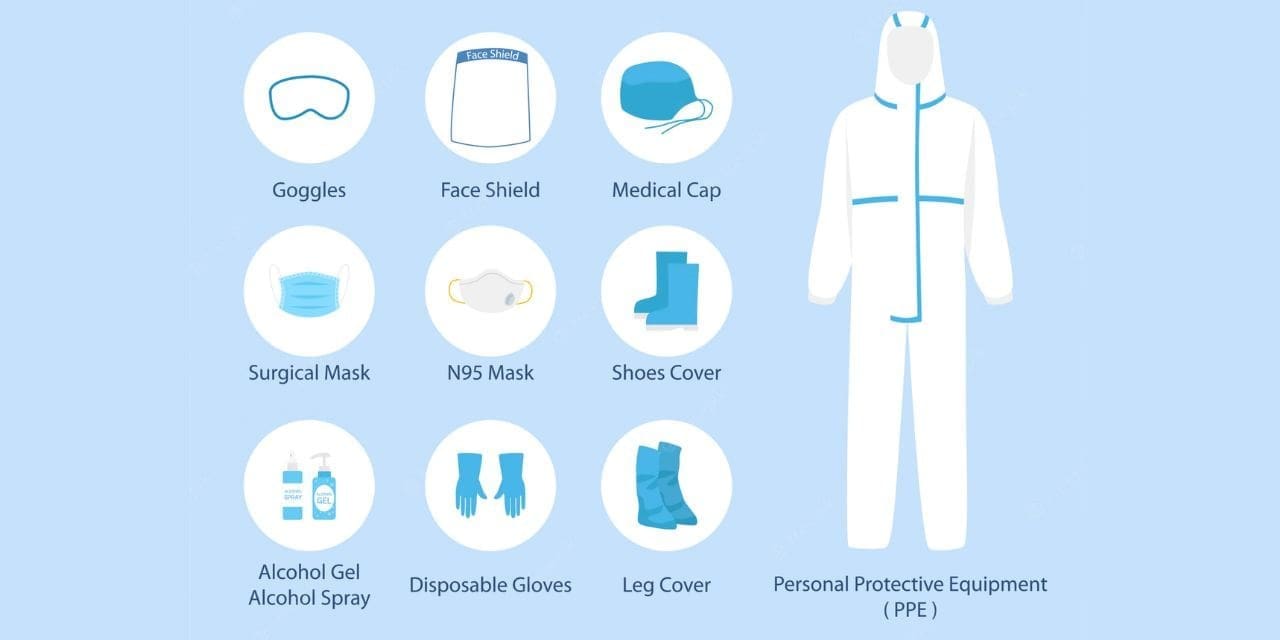Iti Dubey
Ph.D. Research scholar
College of community and applied sciences, MPUAT, Udaipur
PPE- It is the word you may have heard in the past few weeks, particularly for healthcare workers. It stands for Personal Protective Equipment. PPE is used in many fields to protect the person from physical, chemical, and biological hazards Currently, a biological hazard is at its peak due to the spread of COVID-19.
According to the Food and Drug Administration (FDA), PPE works as a barrier between an individual’s skin, mouth, nose, or eyes and viral, bacterial infections. In order to be used in a medical setting, most PPE used are medical gloves, gowns, and N95 respirators regulated by the government agency and must meet their regulations.
Why it is most important for the Health Care Workers?
Healthcare workers (doctors, nurses, and other caregivers) are the front-line workers of the pandemic disease and are therefore more prone to contagious infection. They cannot do social distancing when seeing patients. They need to be close to patients often for prolonged periods, whether taking a history of what a patient’s symptoms are, doing a physical exam to look for clues about what is going, or doing a procedure.
When used properly, PPE acts as a barrier between infectious materials such as viral and bacterial contaminants and your skin, mouth, nose, or eyes (mucous membranes). The barrier has the potential to block transmission of contaminants from blood, body fluids, or respiratory secretions. PPE may also protect patients who are at high risk for contracting infections through a surgical procedure or who have a medical condition, such as, an immunodeficiency, from being exposed to substances or potentially infectious material brought in by others. When used properly and with other infection control practices such as hand-washing, using alcohol-based hand sanitizers, and covering coughs and sneezes, it minimizes the spread of infection from one person to another.
All personal protective equipment (PPE) that is intended for use as a medical device must follow the required regulations and should meet applicable voluntary consensus standards for protection. The consensus standards and the regulations vary depending on the specific type of PPE.
In India now it is mandatory for the manufacturers of personal protective equipment (PPE) to follow the WHO & the union ministry of health and welfare specifications for the production of PPE kit and mark their products with a unique code and tamper-proof stickers as said by the textile ministry. This comes after reports emerged that unapproved products were being sold in the market.
The ministry, in a notification issued on April 6, said the Unique Certification Code (UCC-COVID19) will apply to PPE garments and fabric which pass the laboratory tests laid down by the South India Textile Research Association (SITRA) as well as the Defence Research & Development Establishment (DRDE). The Code will record the type of garment, its test procedure, date of test. The certification will be valid for a certain time period and both SITRA and DRDE will preserve the sample sent by the producer, said the notification.
Components of PPE-
Gown: They are used to protect the wearer from the spread of infection or illness if the wearer comes in contact with potentially infectious patient, liquid and solid material. They may also be used to help prevent the gown wearer from transferring microorganisms that could harm vulnerable patients. Gowns are one part of an overall infection-control strategy. These gowns are made from a variety of synthetic fabrics. They’re mostly disposable or single-user version.
Gloves: Medical gloves are examples of personal protective equipment that are used to protect the wearer or the patient from the spread of infection or illness during medical procedures and examinations. Medical gloves are disposable and usually made of natural rubber, latex, polyvinyl chloride, nitrile or polyurethane.
N95 respirator: An N95 respirator is a respiratory protective device designed to achieve a very close facial fit and very efficient filtration of airborne particles.
The ‘N95’ designation means that when subjected to careful testing, the respirator blocks at least 95 percent of very small (0.3 micron) test particles. It reduces the wearer’s exposure to airborne particles, from small aerosols to large droplets.
Hair cover: It helps to maintain sterility in a work area and protects the worker’s hair and scalp from contamination from airborne pathogens or contaminates.
Full body suit: Synthetic suits designed to prevent accidental transfer of viruses and bacteria to the wearer. They allow wearers to work and move freely among patients. Usually made of a fluid- and air-resistant woven plastic fiber. The suit prevents exposure to body fluids and infectious agents, but it must be removed carefully to avoid contact with pathogens on the fabric. It can also include a hood built into the suit to cover head.
Face shields: Face shields protect workers from contact with splashes and splatters of fluid-borne pathogens from patients. This is especially vital in close proximity. These are designed to protect the entire face. Respirators are worn beneath.
Half-face respirator: These devices provide air filtration and allow the wearer to use goggles.
Powered air-purifying respirator (PAPR): This is used primarily by those working with very ill patients who need constant care for long periods of time. Health care workers can be in the patient’s room up to 12 hours. The device uses a blower to pass contaminated air through a filter that delivers air free of contaminants or airborne particles.
Boots or closed-toe work shoes: Safety boots and shoes with protective toe caps that are penetration-resistant.
These component serves to prevent the wearer from catching infection and are used according to the severity of work zone and proximity with the patient. These are must for the front line workers as they are in constant and direct contact with the patient and most vulnerable from the infection. Therefore these PPE are boon or life saviors for the front line workers.

